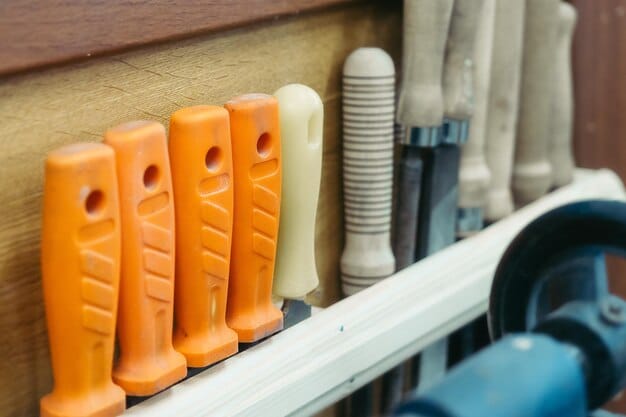Community Tool Library: Unveiling the Benefits for Your Neighborhood

Establishing a community tool library offers a multitude of advantages, including cost savings for residents, promotion of sustainable practices through resource sharing, fostering community engagement and skill-sharing, and reducing environmental impact by minimizing individual ownership of tools.
Are you looking for a way to strengthen your community while saving money and promoting sustainability? Exploring what are the benefits of establishing a community tool library might be the perfect solution. These libraries offer a shared resource pool that empowers residents, reduces waste, and builds stronger connections.
What are the Benefits of a Community Tool Library?
Community tool libraries are gaining popularity as valuable resources that offer a myriad of benefits to local residents and the environment. By providing access to a diverse range of tools, these libraries foster collaboration, reduce individual expenses, and promote sustainable living practices. They are a testament to the power of shared resources and community empowerment.
But what exactly makes them so beneficial? Let’s delve into the specific advantages of establishing a community tool library and how it can transform your neighborhood.
Reduced Financial Burden on Residents
One of the primary benefits of a community tool library is the significant cost savings it offers to residents. Buying tools can be expensive, especially for those who only need them for occasional projects. A tool library eliminates this burden by providing access to a wide range of tools for a small membership fee or even for free.
This affordability is especially beneficial for low-income households, students, and seniors who may not have the financial means to purchase their own tools. Community tool libraries level the playing field, ensuring that everyone has access to the resources they need to maintain their homes, gardens, and pursue DIY projects.
- Access to specialized tools: Tool libraries often stock specialized tools that are rarely used by individuals, saving residents from purchasing expensive equipment for one-time projects.
- Elimination of storage costs: Owning tools requires storage space, which can be a premium in urban areas. Tool libraries eliminate this need, freeing up valuable space in homes and apartments.
- Reduced maintenance costs: Tool maintenance can be time-consuming and expensive. Tool libraries take care of maintenance and repairs, saving members both time and money.
In essence, a community tool library acts as a shared investment, allowing residents to pool their resources and gain access to a much wider range of tools than they could afford on their own.
Promoting Sustainability and Reducing Waste
Sustainability is a growing concern, and community tool libraries offer a tangible way to reduce waste and promote environmentally responsible practices. By encouraging tool sharing, these libraries reduce the need for individual ownership, preventing the unnecessary duplication of resources and minimizing the overall environmental impact.
This reduction in consumption translates to less manufacturing, transportation, and ultimately, less waste. Community tool libraries contribute to a more circular economy, where resources are reused and shared, rather than discarded after limited use.
The Environmental Impact of Tool Sharing
The environmental impact of tool manufacturing and disposal is significant. Every tool requires raw materials, energy for production, and transportation to retail outlets. When individuals buy their own tools, many of those tools sit idle for most of their lives, representing a wasted investment of resources.
Tool libraries help to mitigate this impact by maximizing the utilization of each tool. By sharing tools among many users, the overall demand for new tools decreases, reducing the strain on the environment.

- Reduced demand for new tools: Tool sharing lowers the overall demand for new tools, decreasing the need for manufacturing and resource extraction.
- Extended tool lifespan: With regular maintenance and care, tools in a library tend to last longer than those owned by individuals, further reducing waste.
- Promotion of responsible consumption: Tool libraries encourage people to think twice before buying new tools, promoting a more mindful and sustainable approach to consumption.
By embracing the concept of tool sharing, communities can significantly reduce their environmental footprint and contribute to a more sustainable future.
Fostering Community Engagement and Skill-Sharing
Beyond the economic and environmental benefits, community tool libraries play a crucial role in fostering community engagement and skill-sharing. They create a space where residents can connect, collaborate, and learn from one another. These libraries often serve as hubs for workshops, demonstrations, and other educational activities.
By bringing people together around a shared resource, tool libraries help to build stronger social bonds and a greater sense of community. They are places where neighbors can meet, share ideas, and work together on projects that benefit the entire neighborhood.
Workshops and Educational Opportunities
Many tool libraries offer workshops and classes on tool usage, maintenance, and DIY skills. These educational opportunities empower residents to take on home improvement projects, learn new skills, and become more self-sufficient.
Workshops can cover a wide range of topics, from basic carpentry and plumbing to advanced woodworking and gardening techniques. By providing access to expert instruction, tool libraries help to bridge the skills gap and promote lifelong learning.
- Skill-sharing among members: Tool libraries often facilitate skill-sharing among its members, creating opportunities for experienced users to mentor newcomers.
- Community projects: Tool libraries can serve as a catalyst for community projects, such as building community gardens, renovating public spaces, or creating public art installations.
- Social events and gatherings: Many tool libraries host social events and gatherings, providing opportunities for members to connect, socialize, and build relationships.
The social benefits of a community tool library are undeniable. They create a vibrant and connected community where residents can learn, grow, and build relationships with their neighbors.
Promoting Self-Reliance and Empowerment
Having access to the right tools can empower individuals to take control of their environment and improve their quality of life. Community tool libraries facilitate self-reliance by providing residents with the resources they need to tackle home repairs, garden projects, and other DIY tasks.
This sense of empowerment can be particularly beneficial for marginalized communities and individuals who may lack the resources to hire professionals for every minor repair or project. Tool libraries level the playing field, giving everyone the opportunity to improve their homes and gardens, regardless of their financial situation.
DIY Projects and Home Improvement
One of the most significant benefits of a tool library is the ability to undertake DIY projects and home improvement tasks. With access to a variety of tools, residents can fix leaky faucets, build shelves, paint walls, and perform other tasks that would otherwise require hiring a professional.
This self-reliance not only saves money but also fosters a sense of accomplishment and pride. Individuals who are able to maintain and improve their own homes often experience a greater sense of ownership and connection to their community.
- Increased home value: Home improvement projects, facilitated by access to tools, can increase the value of homes and improve the overall appearance of neighborhoods.
- Creation of community gardens: Tool libraries can provide the tools necessary to create and maintain community gardens, fostering a sense of community ownership and providing access to fresh, healthy food.
- Support for small businesses: Tool libraries can support small businesses and entrepreneurs by providing access to specialized tools that they may not be able to afford on their own.
By promoting self-reliance and empowerment, community tool libraries help to build stronger, more resilient communities where residents are actively engaged in improving their own quality of life.
Economic Benefits for the Local Economy
While the direct benefits of a community tool library primarily accrue to residents, there are also indirect economic benefits for the local economy. By reducing the need for individual tool purchases, tool libraries can help to keep money within the community, supporting local businesses and stimulating economic growth.
Furthermore, the increased level of DIY activity and home improvement projects can lead to increased demand for building materials, plants, and other related services, further boosting the local economy. Tool libraries act as catalysts for economic activity, creating a ripple effect throughout the community.
Supporting Local Businesses
While it may seem counterintuitive, tool libraries can actually support local businesses by increasing the demand for complementary goods and services. For example, residents who are undertaking a painting project may need to purchase paint, brushes, and rollers from a local hardware store. Similarly, those building a garden bed may need to buy lumber, soil, and plants from a local nursery.

- Increased spending on building materials: DIY projects often require the purchase of building materials, supporting local lumberyards and hardware stores.
- Demand for plants and gardening supplies: Community gardens and home gardening projects increase the demand for plants, seeds, and other gardening supplies, supporting local nurseries and garden centers.
- Creation of jobs and economic opportunities: The increased level of DIY activity can lead to the creation of jobs and economic opportunities in the local economy.
By fostering a culture of DIY and home improvement, community tool libraries help to create a vibrant and thriving local economy.
Enhancing Community Resilience and Adaptability
In an increasingly uncertain world, community resilience is more important than ever. Community tool libraries contribute to community resilience by providing residents with the resources they need to cope with unexpected challenges, such as natural disasters or economic downturns.
Having access to tools for home repair, gardening, and other essential tasks can help residents to become more self-sufficient and less reliant on external aid during times of crisis. Tool libraries serve as vital community assets, providing a safety net for residents when they need it most.
Preparing for Emergencies and Disasters
During emergencies and disasters, access to tools can be critical for survival and recovery. Tool libraries can provide shovels, saws, axes, and other essential tools for clearing debris, repairing damaged homes, and providing emergency assistance.
By mobilizing quickly and distributing tools to those in need, tool libraries can help communities to recover more quickly and effectively from disasters.
- Supporting community relief efforts: Tool libraries can serve as staging areas for community relief efforts, providing a central location for distributing tools and supplies to those affected by a disaster.
- Promoting community preparedness: Tool libraries can offer workshops on disaster preparedness, teaching residents how to use tools safely and effectively in emergency situations.
- Building a culture of mutual aid: Tool libraries foster a culture of mutual aid, where residents are willing to help one another during times of crisis.
By enhancing community resilience and adaptability, community tool libraries help to create stronger, more self-reliant communities that are better prepared to weather any storm.
| Key Benefit | Brief Description |
|---|---|
| 💰 Cost Savings | Reduces individual tool purchase costs, especially for occasional use. |
| 🌳 Sustainability | Promotes resource sharing, reduces waste, and lowers environmental impact. |
| 🤝 Community Building | Fosters connections, collaboration, and skill-sharing among residents. |
| 💪 Empowerment | Enables self-reliance, DIY projects, and enhances quality of life. |
FAQ
A community tool library operates like a regular library, but instead of books, it lends out tools. Members can borrow tools for a specified period, often with a small fee or deposit.
Tool libraries usually have a wide range of tools, including gardening tools, power tools, hand tools, and specialized equipment for home repair and construction projects.
Most community tool libraries are open to residents of the local community who meet certain eligibility requirements, such as paying a membership fee and agreeing to the library’s rules.
Yes, there are potential risks, such as tool damage or injury. Tool libraries typically have safety guidelines and require members to sign a waiver acknowledging these risks.
Starting a tool library involves assessing community interest, securing funding, acquiring tools, and establishing policies. Partnering with local organizations can also be beneficial.
Conclusion
In conclusion, the benefits of establishing a community tool library are extensive, spanning economic, environmental, and social dimensions. These libraries not only provide affordable access to tools and promote sustainability but also foster community engagement, self-reliance, and resilience. By embracing the concept of shared resources, your community can strengthen its social fabric, reduce its environmental footprint, and empower its residents to build a brighter future.





